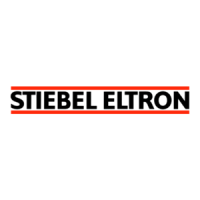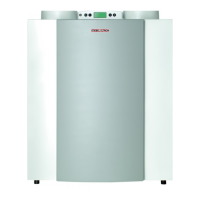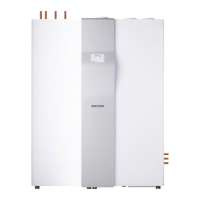26
2.6 Commissioning
Only approved contractors may commission
this equipment and instruct the owner in its
use.
Commission this equipment in accordance
with these operating and installation
instructions. Before doing so, check the
following points:
Ventilation system
Have the ventilation ducts been correctly
routed and insulated?
Heating system
Was the heating system filled up to the
correct pressure, and was the quick
acting air vent valve opened?
DHW cylinder
Was the DHW cylinder filled (open the
water valve, until water flows out)?
Temperature sensor
Were all temperature sensors correctly
placed and connected?
Mains connection
Was the power supply properly
connected?
Then heat up the system to its maximum
operating temperature and vent again.
Observe the maximum system
temperature in underfloor heating
systems.
Operating the equipment (ventilation
and heat pump) is not allowed whilst
building work is being carried out.
To dry out a building, operate this
equipment in accordance with point 2.7.1.
2.6.1 Heating only with the electric
booster
(Switch OFF the heat pump and ventilation)
To heat only with the electric booster system,
set the control unit to emergency mode with
the flap closed.
Before any work, isolate the
equipment from the power supply at
the control panel.
System configuration
The integral equipment control unit regulates
the following three functions:
1. Heating
2. Ventilation
3. DHW heating
The control unit defaults are set to meet the
basic needs of most users. The system controls
may need to be matched to the users’ specific
needs or to the special characteristics of the
building. Which is possible via control level 3.
System configuration according to the
settings in the commissioning report. The
commissioning report contains all settings for
the control unit function. In case the system
operates incorrectly, initially check settings
against the commissioning report.
2.7 Maintenance and cleaning
2.7.1 Cleaning
Keep the air inlet and outlet
apertures in the outside walls free
from snow and leaves.
Check the evaporator fins from time to time
(e.g during filter changes) for contamination.
If the heat pump operation is impaired
through deposits of corrosion by-products
(rust sludge) inside the heating systems
condenser, the customer service can only
use suitable solvents and a flushing pump to
dissolve such deposits.
Regularly check the condenser drain. Remove
dirt and blockages.
Heat meter
If heat meters are installed, frequently clean
their strainers, which block easily.
Protective anode
A protective anode is integrated into the DHW
cylinder to protect it against corrosion.
The protective anode is pushed through
the flange from inside out and secured. For
inspections, the flange will be removed to
enable the simultaneous inspection of the
electrode, the immersion heater and the
internal enamel coating. When replacing
anodes, ensure a perfect contact with a
metallic, conductive surface during assembly.
The timing of the inspection is subject to
the local water quality and is determined by
your local contractor (recommendation: First
inspection no later than after two years).
2.7.2 System safety equipment
Safety valve (on-site provision)
This valve opens when the water pressure
exceeds the preset value of 6 bar, thereby
relieving the pressure. It is adjusted so that
no water will be expelled when heating
is switched OFF. Should it continue to drip
excessively, either the valve seat has become
contaminated, the water pressure is too high
or the pressure reducing valve has become
faulty.
Pressure reducing valve (on-site provision)
Check the valve for perfect function. Replace it,
if required.
Regular valve maintenance
Safety requires that valves are regularly
checked for perfect function. How quickly
lime scale builds up depends on the local
water quality. As your local contractor is
familiar with your local water quality, let him
determine the timing of this inspection.
Expansion vessel
Check the flow pressure in the unpressurised
condition.

